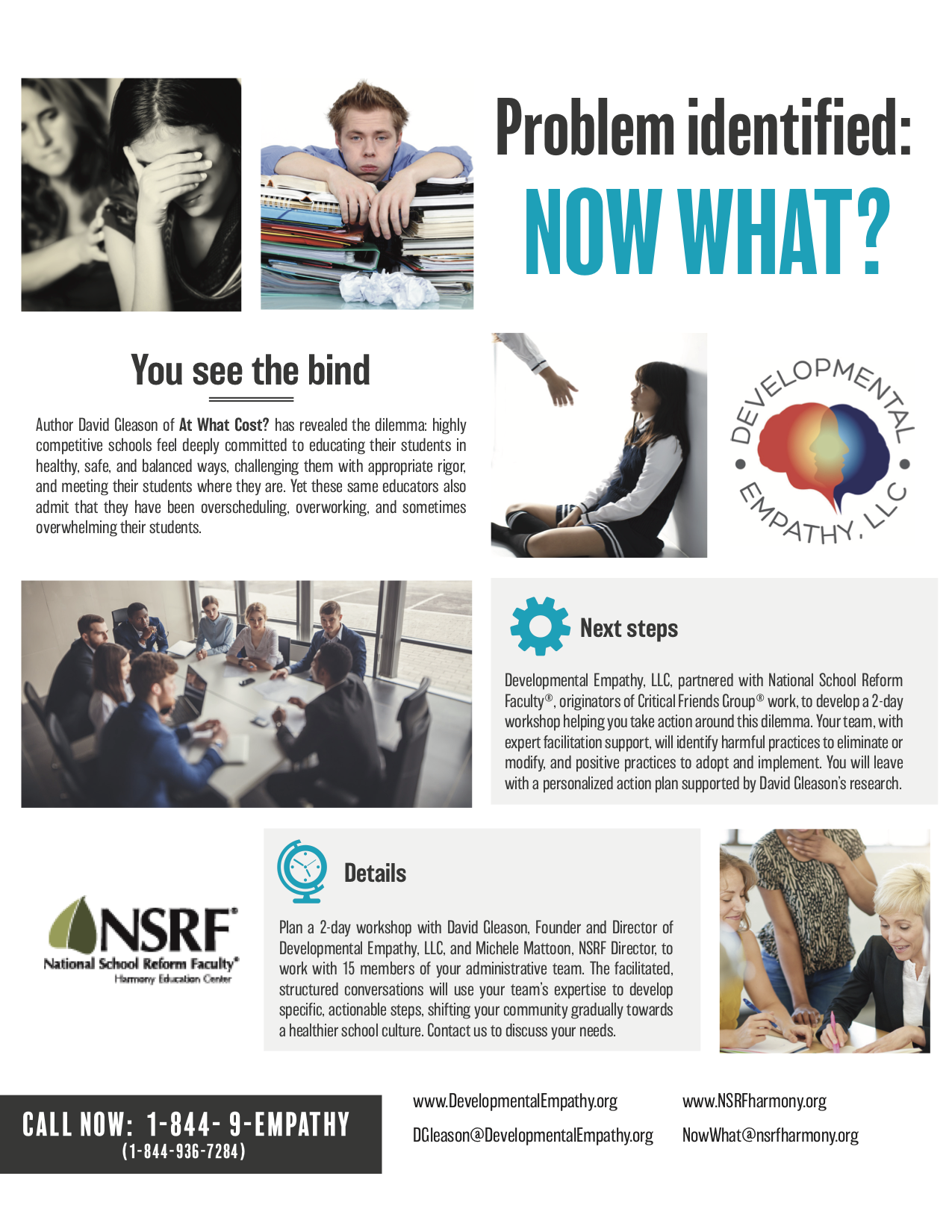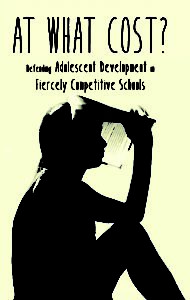
by David Gleason | Sep 24, 2018 | Blog
Due in large part to the ultra-competitive culture that has characterized the current generation of students since preschool, many students are extremely overscheduled, and consequently, feel stressed and pressured to succeed in everything. As a result, they often experience intense feelings of anxiety, frustration, helplessness, and depression.
One of my adolescent clients, Spencer, a recent high school graduate, articulated what caused her the most stress during high school:
“It wasn’t just one thing, it was always about four or five things that were happening all at once! …On the same day that I would have a big math test, I’d also have a history paper due, a presentation to give in English class, and then an away track meet that would take all afternoon and into the evening. …Then I would get home to do a ton of homework that would be due for the very next day. This kind of schedule basically defined my entire high school experience.”
In my clinical practice working with adolescent clients for more than 25 years, I have observed that Spencer’s experience has become more the rule than the exception.
Over the past decade, I have treated so many adolescents who have been chronically sleep-deprived and anxious, teens whose persistent anxiety has led to associated behavioral troubles, including substance abuse, eating disorders, cutting, self-injury, and too frequently, suicide.
In my book, At What Cost? Defending Adolescent Development in Fiercely Competitive Schools, http://bit.ly/2EryYOf I detail several key developmental and neurobiological reasons why overscheduling children and adolescents can be so detrimental, if not utterly dangerous. Since my book was published in 2017, I have learned of yet another neurobiological reason why overscheduling students isn’t just detrimental to their still-developing status, but also can interfere with their maturing social-emotional and executive control capacities — both fundamental necessities for all students’ current and long-term health and development.
Overscheduling Interferes with Healthy Brain Development
Specifically, I have learned that within the ever-expanding body of compelling neuroscience research, “one major advance shows how the brain’s Default Mode Network supports social-emotional feelings and broader thought patterns associated with self-processing, identity, meaning-making, and future-oriented thought.” [1]
In an earlier blog post, “Does More ‘Free Time’ Mean More ‘Screen Time’ for our Students,” http://bit.ly/2NjGNL7 I advocated that we — parents, teachers, and administrators — offer students more “free time” as a way to help them compensate for their frenetic daily schedules. I emphasized that, in order to prevent students from simply engrossing themselves in their cell phones, we also need to be more explicit about how they can use this free time in ways that promote health and well-being.
The discovery of the brain’s Default Mode Network provides additional and incontrovertible neurobiological evidence for why students need to have more unstructured time — it is as basic a human developmental need as getting enough sleep, exercising regularly, and eating a balanced diet.
Key Brain Network is Most Active When We’re Not Engaged
Among the many interrelating networks within the brain, “the most metabolically expensive core brain areas are organized into a grand network whose activity and connectivity are broadly associated with neural and mental health, intelligence and memory skills. This grand brain network, called the Default Mode Network (DMN), engages regions not only in the brain’s core but also in key lateral parietal areas.” [2]
Perhaps most importantly, “The DMN was named for the fact that its component brain regions become highly active and functionally connected only when people daydream or wakefully rest in the fMRI scanner, compared with when they perform demanding cognitive tasks.” [3]
As researchers have queried, “How could the brain’s most metabolically expensive regions be more active when people are resting?” [4]
After about 15 years of research, “scientists now broadly accept that these coordinated DMN activations are critical for psychological functioning, especially for mind states that move the thinker out of the physical, visible, actionable specifics of the here-and-now. The Default Mode Network is heavily recruited during all sorts of tasks that involve internally directed, interpretive, and reflective thought, for example, when remembering past experiences, imagining hypothetical or future scenarios, or deliberating on inferred, abstract, or morally relevant information.” [5]
Research has “unequivocally shown the DMN is not equally active all the time. Instead, the DMN seems to trade off with brain networks that support outward attention, physical action and instrumental task orientation.” [6]
Further, “The DMN will be relatively quiet and inactive when people engage in mental activities with short-term, context-specific goals, such as solving math problems, listening to a teacher’s instructions, playing sports or action video games, or checking their cell phones. These tasks deactivate the Default Mode Network because they require outward perceptual attention.”[7]
Therefore, “The neural networks responsible for maintaining and focusing attention into the environment and engaging in finite, task directed, and physical activity toggle with the default mode network.
These two modes of attention – inward reflection supported by the default mode network, and outward attention, perception, and action – do NOT normally co-activate. This means that it is not neurologically possible to simultaneously devote full attention to completing one’s current tasks while also reflecting on the broader meaning of these tasks now and into the future.” [8]
Lack of Down-Time Hinders Students’ Brain Development
Those of us dedicated to educational practice and policy today must then ask: “How could going back to school … and thereby, losing long periods of free or unstructured time ….be considered a major loss for many students?”
Essentially, since the brain’s Default Mode Network is only activated during periods of free and unstructured time, in the currently overscheduled and frenzied environment within fiercely competitive schools, “relentlessly demanding students to focus in the here-and-now on completing the [multitude of] concrete tasks assigned to them could undermine students social-emotional meaning making, identity development, conceptual understanding, and ultimately, their long-term academic success.” [9]
The logical conclusion, according to Mary Helen Immordino-Yang and many other neuroscience researchers, is that “consistent with common sense and a focus of current research, is that educational environments that overly focus on task orientation and quantitative measures of success such as test scores and grades may sometimes increase achievement and productivity in the short-term by focusing teachers on what works now and [by focusing] learners on completing concrete tasks for near-term rewards. But, overly strong task/testing orientation may inadvertently undermine genuine meaning making, critical thinking, creativity, and well-being over time, leading students to lose (or never to build) intrinsic motivation, resilience, and personal connection to [their] academics and scholastic achievement.” [10]
In her concluding remarks to this important article, Immordino-Yang states, “In sum, corroborating classic education research on how people learn, new evidence on brain functioning suggests that many of the mainstream educational practices meant to increase productivity and accountability may be incompatible with how the brain works and how people think, and could inadvertently undermine student achievement and life success. The evidence backs up what last century’s wise teachers could have told you: Young people need downtime, reflection time, and strong social relationships to learn optimally. [11]
To be sure, “Schools are designed to teach specific procedures and semantic content. But pushing students’ hard work in the moment … without supporting the broader psychological and neurological landscape of the developing person … is misguided, because it fails to help students more adaptively interpret their educational experiences in terms of their own identity development and possible futures.”[12]
We — the adults who to one degree or another, are complicit in adding stress to young people’s lives — need ourselves to reflect on these findings.
[1] Immordino-Yang, M.H. (2106). Emotion, Sociality, and the Brain’s Default Mode Network: Insights for Educational Practice and Policy. Behavioral and Brain Sciences, Vol.3(2) 211-219.
[2] Buckner, R.L., Andrews-Hannah, J.R. & Schacter, D.L. (2008). The brain’s default network: Anatomy, function, and relevance to disease. Annals of the New York Academy of Sciences, 1124, 1-38.
[3] Raichle, M.E., MacLeod, A.M., Snyder, A.M., Powers, W.J., Gusnard, D.A., & Shulman, G.L. (2001). A default mode of brain function. Proceedings of the National Academy of Sciences of the United States of America, 98, 676-682.
[4] Ibid
[5] Immordino-Yang, M.H, Christodoulou, J,. & Singh, V. (2012). Rest is not idleness: Implications of the brain’s default mode for human development and education. Perspectives on Psychological Science, 7, 352-364.
[6] Fox, M.D., Snyder, A.Z., Vincent, J.L., Corbetta, M., Van Essen, D.C., & Rachle, M.E. (2005). The human brain is intrinsically organized into dynamic, anticorrelated functional networks. Proceedings of the National Academy of Sciences of the United States of America, 102, 9673-9678.
[7] Immordino-Yang, M., McColl, A., Damasio, H., & Damasio, A. (2009). Neural correlates of admiration and compassion. Proceedings of the National Academy of Sciences of the United States of America, 106, 8021-8026.
[8] Immordino-Yang, M.H. (2106). Emotion, Sociality, and the Brain’s Default Mode Network: Insights for Educational Practice and Policy. Behavioral and Brain Sciences, Vol.3(2) 211-219.
[9] Immordino-Yang, M.H. (2106). Emotion, Sociality, and the Brain’s Default Mode Network: Insights for Educational Practice and Policy. Behavioral and Brain Sciences, Vol.3(2) 211-219.
[10] Ibid
[11] Ibid
[12] Ibid

by David Gleason | Jul 26, 2018 | Blog
For the past two years, I have been intrigued by what I have come to appreciate as a profoundly effective methodology for professional development for adults in schools, as well as in many other organizations, such as in businesses and healthcare institutions.
Two years ago, I witnessed the undeniable value of Critical Friends Groups ® in action during a visit the ACS Athens. Critical Friends Groups ® is a structured and highly engaging approach to faculty professional development in schools, and it is currently utilized in many independent and international schools throughout the US and around the world.
I was struck immediately by how collaborative and trusting this group of 12 faculty members was with each other. Each group member contributed, like a peer-consultant, to help another member generate possible solutions to the particularly challenging classroom dilemma she had presented to the group.
In a follow-up conversation with that group’s leader – a member of the ACS Athens faculty – I learned that more than 80% of the teachers in this K-12 international school had been participating in these “collaborative learning communities” (so named by the school) as their primary approach to professional development for three-to-five years by then, and that their collective sense of cohesiveness and teamwork as a full faculty were very well-established.
These collaborative learning communities had been meeting monthly for two hours, on school-sanctioned time, allocated explicitly for faculty professional development.
I watched this diverse group of educators (representing 13-grade levels and all academic disciplines) as they brainstormed, asked probing and clarifying questions that fed off one another, conveyed understanding and validation to the presenter, and ultimately, generated numerous possible solutions for this one teacher’s dilemma.
I was struck by how effective this approach was — and is — in contrast to the most common and, in my opinion, least effective approach to real professional development for adults in schools.
Typical professional development consists of teachers and administrators leaving their schools to attend conferences, where they listen to content-specific presentations, often in large lecture halls among total strangers. They then return to their schools, only to resume “business – or teaching – as usual.” While the insights and curricular lessons gleaned in these conferences can be valuable, they rarely – if ever – lead to the full faculty’s actual growth and development.
While observing these professional learning groups, in and of itself, was incredibly heartening, its major impact on me was the unexpected realization that these collaborative learning groups could play a vital, if not pivotal, role in advancing my mission: to promote “developmentally empathic” practices and policies in schools everywhere.
This is what motivated me recently to participate in an “Open Training” at National School Reform Faculty (NSRF) in Bloomington, Indiana, in an effort to become certified as a Critical Friends Groups ® coach In my “open training” week, I realized that while my original observations of Critical Friends Groups ® portrayed individual faculty members presenting their own unique dilemmas to their fellow group members, these protocol structures are also adaptable and applicable to larger-group quandaries and challenges, such as an entire faculty’s desire to become a more developmentally empathic school. As I describe in my book, At What Cost? – anxiety, depression, and their dangerous manifestations, including substance abuse, eating disorders, self-injury and suicide – are increasing student conditions at many competitive high schools throughout the U.S. and all around the world. Paradoxically, most of these schools promote themselves as being committed to their students’ holistic development in academics, athletics, and the arts, and in their personal, social, and emotional growth. Unfortunately, these dedicated educators all around the world fully admit to overscheduling, overworking and, at times, overwhelming their students.
This conflict – adults wanting to educate students in healthy, safe, and balanced way but, at the same time (and against their best intentions), overscheduling, overworking, and overwhelming them – reflects a true bind for these well-meaning adults.
Fortunately, and to their tremendous credit, after admitting to this bind, they ask, “What do we do now? How can we begin to reclaim our primary commitments to the healthy and balanced education for our students?” For the past two years – since the publication of At What Cost? – I have been presenting at schools and conferences around the world with the primary mission of trying to expose the conflicting dynamics of the adults’ bind, and then to recruit these adults – educators and parents alike – to try to begin making changes that help them to (1) validate and reclaim their original and primary missions of wanting to educate and parent their students in healthy, safe, and balanced ways, and (2) recognize and respect their students’ still-developing status as children and adolescents who are simply not ready to manage the amount of pressure and stress that is imposed on them by the adults in their lives and by the ultra-competitive culture at large.
Helping Well-Intentioned Adults to Make Changes Necessary to Benefit Adolescents
One of the main lessons I have learned throughout these various presentations is that these well-meaning educators already feel so pressed for time in their busy, often hectic, lives and jobs, that even though they truly want to begin making developmentally empathic changes, they are just not sure of how to actually start what feels to them to be a somewhat overwhelming – if not daunting – change process.
New Partnership with National School Reform Faculty
To address this issue, and to provide schools with a practical and realistic option for beginning this change process, my consulting group, Developmental Empathy LLC, has recently partnered with National School Reform Faculty (NSRF), to design a straightforward “next step” intervention for schools to employ to review their current maladaptive practices and to begin generating achievable goals and concrete plans for changing them in the developmentally empathic direction. Specifically, Developmental Empathy LLC and National School Reform Faculty have designed a two-day professional development workshop to facilitate the start of this challenging change process.  At the end of this two-day workshop, participants (administrators, teachers, and/or parents from the same schools), will have generated real and actionable “next steps” in the process of making long-term adaptive changes. As Michele Mattoon, Director of NSRF, has succinctly stated, “At What Cost? clearly provides the why for schools to change: NSRF can help provide the how.” I couldn’t agree more.
At the end of this two-day workshop, participants (administrators, teachers, and/or parents from the same schools), will have generated real and actionable “next steps” in the process of making long-term adaptive changes. As Michele Mattoon, Director of NSRF, has succinctly stated, “At What Cost? clearly provides the why for schools to change: NSRF can help provide the how.” I couldn’t agree more.

by David Gleason | Jun 12, 2018 | Blog
On yesterday’s “Morning Edition,”, as part of National Public Radio’s (NPR) series, “How to Raise a Human,” Allison Aubrey featured Savannah Eason of Wilton, Connecticut, who – as a high school student in 2012 – was strongly considering suicide when her father wrestled a pair of scissors from her hands.
“I needed somebody to do something,” she says, and recalls that the pressure she felt “to succeed and aim high had left her feelings anxious and depressed.”
As Savannah told NPR, “The thoughts that went through my head were, ‘this would be so much easier if I wasn’t alive, and I just didn’t have to do anything anymore.’ ” This six and-a-half-minute audio story, “The Perils of Pushing Kids Too Hard, And How Parents Can Learn to Back Off,” is well worth a listen. Listeners will not be surprised to learn that the ultra-pressured conditions that afflicted high school students in 2012 have only intensified in 2018.
Young Adults Today are at Forefront of Dangerous Mental Health Crisis
In fact, as generational writer, Jean Twenge, states in her recent book, iGen: Why Today’s Super-Connected Kids Are Growing Up Less Rebellious, More Tolerant, Less Happy–and Completely Unprepared for Adulthood–and What That Means for the Rest of Us,”the children born between 1995 and 2012 are now at the forefront of one of the most dangerous mental health crises in decades.”
I urge you to click on the audio link and listen to NPR’s brief story. When I heard it, I felt compelled to share it as a way – once again – of reinforcing the crisis conditions in which so many younger and older adolescents (middle and high school students) are constantly embedded.
THESE are the conditions of which I have written in detail in At What Cost? Defending Adolescent Development in Fiercely Competitive Schools. Please listen and share with your networks. Thank you.

by David Gleason | May 31, 2018 | Blog
Earlier this year, I joined a diverse group of about 20 other professionals from education, media, business, law, and healthcare, who came together for a single purpose: our shared concerns about the increasingly troubled descriptions that currently characterize “young adult well-being.”
Specifically, too many of today’s college students are entering their undergraduate years already feeling spent – exhausted, anxious, and depressed.
While each participant had a slightly different perspective on the status of “young adult well-being,” each of us acknowledged that too many college students are suffering in significant social, emotional, and behavioral ways. That reality often has alarming origins in these students’ earlier life and school experiences and disturbing implications for their increasingly precarious post-college futures. I should note that while our discussions addressed the problems of those whose afflictions have had serious consequences (e.g., attempted suicide), we focused primarily on the larger group of students: those whose overall well-being seems so tenuous.
“I feel like I’m doing something wrong if I’m not doing anything.”
While I’ve had direct clinical experience with the mental health challenges faced by adolescents and young adults, several recent articles have given me some new perspectives on the situation. In a recent Washington Post story, “Why are young adults the loneliest generation America?,” Rachel Simmons interviewed college students across the country and reported that many students “fear that if they are not constantly busy studying or attending meetings, something must be wrong with them, with the schedule or with their work ethic.”
Simmons found that many college students are accustomed to being highly scheduled and always busy, often to their detriment: “These new norms of stress culture translate to fewer opportunities to let [the students’] conversations and minds wander.” One of her students admitted, “I can’t have downtime … I feel like I’m doing something wrong if I’m not doing anything.”
These comments are similar to those I detail in At What Cost? Defending Adolescent Development in Fiercely Competitive Schools. According to Simmons, “To be overwhelmed and constantly busy are the new baselines, and anything less, for many young adults, feels lazy.” Perhaps most poignantly, as Simmons notes, “Constant busyness takes a toll not only on the [students’] quality of relationships, but also on the skills young adults use [or don’t know how to use] to forge them.” Simmons appropriately asserts, “Skills are like muscles: they need to be flexed repeatedly. Friend-making skills atrophy [or never develop] from underuse.”
Teaching College Students How to Live “the Good Life”
Then, like a breath of “young adult well-being” fresh air, in another recent article, Less cramming. More Frisbee. At Yale, students learn how to live the good life, Susan Svrluga highlighted a wildly popular course at Yale University. In an action intended to be a provocation of sorts, the 1,200 students taking Professor Laurie Santos’s class, “Psychology and the Good Life” (the largest class ever offered at Yale in its 317-year history) were given the unexpected gift of a canceled class … with one caveat: “they couldn’t use the hour and a quarter of unexpected free time to study – they had to just enjoy it.” For the next 75 minutes, the students – roughly 25% of the entire undergraduate student body – played frisbee, made music, took naps, ate lunch, went to a museum, and/or generally relaxed.
Obviously, an unexpected canceled class can’t even come close to being considered a remedy for what Professor Santos had observed: “Many students were stressed out and unhappy, grinding through long days that seemed far more crushing and joyless then [my] own college years.”
As Svrluga described, Professor Santos’s perception has been backed up by statistics, including a national survey that found “nearly half of college students reported overwhelming anxiety and feeling hopeless.” As Santos is quoted in this informative article, “Students feel they’re in this crazy rat race, they’re working so hard they can’t take a single hour off – that’s awful.”
Impressively, Professor Santos shared a pared-down version of her Yale course on the online education site, Coursera, and within two months of its launch, more than 91,000 people from 168 countries were taking the course.
Rat Race Starts Years before Students Enter College
To be sure, this “crazy rat race” to which Professor Santos refers starts years before students ever even apply to college. Ironically, former Yale Professor William Deresiewicz, in his recent book, Excellent Sheep: The Miseducation of the American Elite and the Way to a Meaningful Life, chronicles how this “crazy rat race” evolved and became so prominent over the past 150 years.
For a variety of combined social and economic reasons, the typical college admissions process of the mid-to-late 1800s gradually shifted from an old “aristocracy model” – characterized by maintaining wealthy connections and perpetuating social capital – to the not-so-new “meritocracy model” of the late 1900s and early 2000s – characterized primarily by students needing to earn consistently high academic grades and exceptional standardized test scores.
The long-term effects of this now-excessive meritocracy model are that children, from as young as in their preschool and kindergarten years, are unwittingly enlisted in – and programmed for – this “crazy rat race” through their elementary, middle and high school years … not just to be “in it” but to “win it.”
Essentially, the pressures imposed on young children and adolescents to compete with each other interfere with, if not usurp, their otherwise natural tendencies to connect with each other.
It is these “competition vs. connection” conditions that frequently set students up, over time, for feelings of social isolation and “disconnection” from their peers, and then to feelings of anxiety and depression and to various harmful acting-out behaviors, including suicide, as “more teenagers and young adults die from suicide than from all medical illnesses combined.”
When my colleagues — the diverse group of educational, media, business, law, and healthcare professionals — and I convene again in the coming months, we will certainly have much to deliberate. The fact that “nearly half of college students report overwhelming anxiety and feelings of hopelessness;” and that many feel so entrenched in this “crazy rat race … working so hard they can’t take a single hour off” is both alarming and absurd.
Ultimately addressing the disheartening status of young adult well-being will necessarily involve making major systemic and adaptive changes – involving parents and educators associated with schools at all levels, including colleges.
As Professor Santos at Yale has demonstrated, sometimes improving young adult well-being can be as simple as canceling class and requiring that students to do anything but study…and relax. In next month’s blog, I’ll explore the neurological underpinnings of the phenomena that these two articles bring to light.

by David Gleason | Apr 27, 2018 | Blog
The 2018 college admissions season is winding down, at least officially. The most selective colleges have made their decisions about whom they’ve accepted, waitlisted, and rejected. Now the students have to make their choices based on whatever options are now available to them.
May 1, also known as National College Decision (or Signing) Day, is the deadline for students to make deposits to attend the college of their choice. One might think that for these students—the ones whose “choice” coincides with their preferences — the stress of the college process would seem to be over. However, whether you’re Michael Brown from Houston, Texas, who applied and was admitted to 20 selective colleges and was granted full scholarships to all of them, or you’re one of the many thousands of highly qualified students all around the world who were either waitlisted or rejected by many of their first and second choice colleges, this phase of the college process can still be daunting, if not wrenching.
Consider two students I have met in the past few weeks who have just experienced the process firsthand. Though the outcomes of their college quests were totally different, their reactions were strikingly similar.
Feeling “Empty” After Ivy League College Acceptance
Ariana was accepted to an Ivy League college, but that acceptance did not result in feelings of satisfaction or celebration. Instead, as she said to me, “I feel like I’ve been working and working and working for this acceptance for my entire school life … and now that I’ve got it, I don’t really care about it. I feel kind of empty. I’ve been thinking things
like…‘After all that dedication and hard work, after all the times I did what I was supposed to do instead of what I wanted to do … after years and years of all that, is there more to life than just an acceptance to a good college?’
“Quite honestly, if I were to die today, I guess you could say – at least on paper – that I’ve had a ‘successful life,’ but I definitely didn’t enjoyed it that much. I’m realizing how much of my childhood and adolescence I have missed.”
“Isn’t there more to life than just an acceptance to a good college?”
The other student, Jacob, applied to 12 colleges, many of which were highly selective, but a few Jacob had considered to be “safety schools” to which he thought he would likely be admitted. Jacob was accepted to one college (not even close to his first choice), waitlisted at two others, and rejected by all the rest.
Think about it: Jacob received nine rejection letters from colleges for which – on paper – he seemed to fit. Like Ariana, Jacob had also been a very diligent student. He, too, had “worked and worked and worked” throughout his entire education to date, often depriving himself of sleep not only to complete his homework but to complete it in a high-quality, organized, and thoughtful way. Jacob earned high grades in school; is kind and very conscientious; is a captain of his school’s track and debating teams; volunteers at a local elementary school tutoring children in math, and earned a near-perfect score on his ACT.
With solid recommendations from teachers and from his college counselor, Jacob had applied early-decision – with hopeful optimism – to his top-choice school and was deferred, only to be rejected in the regular admissions decision round. His reaction? “Isn’t there more to life than just an acceptance to a good college?”
Admitted or Rejected: Students Feel Defeated After College Decisions
 Jacob and Ariana are both incredibly dedicated and committed students; both are kind and considerate individuals; both earned mostly As in their secondary school years in very demanding courses, and each earned very high scores on their standardized tests. And yet sadly, both were similarly sunk in gloom, regardless of their diametrically opposed college acceptance outcomes.
Jacob and Ariana are both incredibly dedicated and committed students; both are kind and considerate individuals; both earned mostly As in their secondary school years in very demanding courses, and each earned very high scores on their standardized tests. And yet sadly, both were similarly sunk in gloom, regardless of their diametrically opposed college acceptance outcomes.
What are we doing to our kids? Ariana gets admitted to an Ivy League college and feels empty and depressed. Jacob gets rejected by most of the colleges to which he applied, and he feels empty and depressed, too.
“Educational Arms Race” Damages Students’ Mental Health
As I have detailed in my book, At What Cost? Defending Adolescent Development in Fiercely Competitive Schools, many educational professionals have termed what we’re doing to our kids as subjecting them to an “educational arms race,” one in which the competition among the students is fierce and constant.
In his book, former professor at Yale University, Professor William Deresiewicz, describes the entire college admissions process as “the fulcrum on which the system turns [as it] casts its shadow back over childhood and adolescence and forward over college and career, shaping the way that kids are raised and thus, the people they become.”
In a 2015 essay, New York Times columnist Frank Bruni echoed the sentiment: “For too many parents and their children, acceptance by an elite institution isn’t just another challenge, another goal. A ‘yes’ or a ‘no’ from [an elite college or university] is seen as the conclusive measure of a young person’s worth, an uncontestable harbinger of the accomplishments or disappointments to come. Winner or loser: this is when the judgment is made. This is the great, brutal culling.”
This year, as we have on previous May 1st college decision deadlines, we are watching the fallout of the “fulcrum’s” emotional impact. As still-developing adolescents, too many high school seniors have the false perception that the colleges to which they’ve either been accepted or rejected reflect — what Bruni called — “the conclusive measure of [their] worth,” and that these college decisions also reflect “uncontestable harbingers of [their] accomplishments or disappointments to come.”
While it is certainly true that some of these highly qualified students are happy with their college admission results, many thousands of qualified students are experiencing varying degrees of emptiness and depression-like Ariana and Jacob — and are working hard to integrate those feelings into their evolving sense of themselves.
To be sure, this “fulcrum” continues to have a pernicious impact on thousands of children and adolescents, as well as on their parents, who anxiously enroll their children in the educational arms race at very early ages, signing them up for years of academic, extracurricular, and social-emotional pressure with the hope that their kid will someday be a “winner” and gain acceptance to a top-tiered college. As Bruni stated, “winner or loser: [the college admission decision] is when the judgment is made.”
Victory in the Competitive College Admissions Process Can Be Elusive
The cruel irony that I have observed with students like Ariana and Jacob is that this “brutal culling” of the college admission process can negatively affect the so-called “winners” just as often as it does the “losers.” Victory in this college admissions process is an elusive thing.
Not surprisingly, the cumulative negative impact of this process is manifest in the increasingly strenuous efforts and resources that colleges and universities are devoting to their incoming first-year students – “winners” and “losers,” depending on the students’ choices – because so many of them arrive on campus already spent, anxious, and depressed.
Again I ask: What are we doing to our kids?







 Jacob and Ariana are both incredibly dedicated and committed students; both are kind and considerate individuals; both earned mostly As in their secondary school years in very demanding courses, and each earned very high scores on their standardized tests. And yet sadly, both were similarly sunk in gloom, regardless of their diametrically opposed college acceptance outcomes.
Jacob and Ariana are both incredibly dedicated and committed students; both are kind and considerate individuals; both earned mostly As in their secondary school years in very demanding courses, and each earned very high scores on their standardized tests. And yet sadly, both were similarly sunk in gloom, regardless of their diametrically opposed college acceptance outcomes.